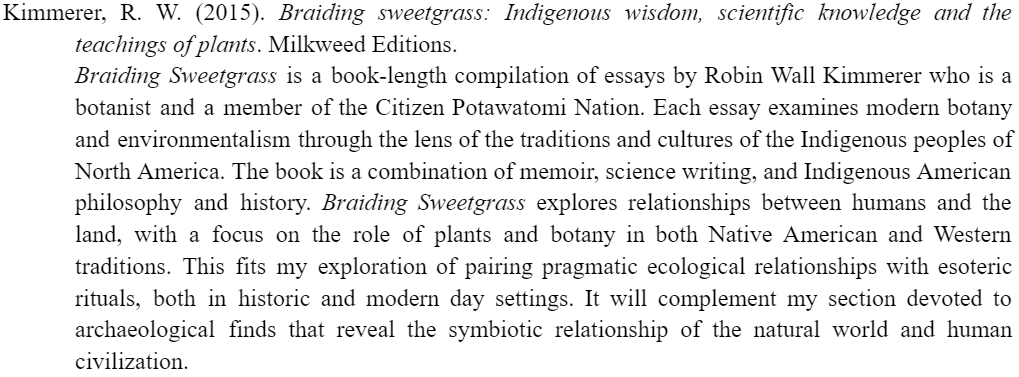Click here to download a .pdf copy of our Annotated Bibliography Handout!
Last updated: July 18, 2024
Consider keeping a printed copy to have when writing and revising your resume! If you have any additional questions, make an appointment or email us at writing@boisestate.edu!
Writing an Annotated Bibliography
An annotated bibliography is a collection of citations (a bibliography), like a References or Works Cited page, with written annotations for each entry that summarizes and then critically evaluates the source. Annotated bibliographies are a process tool, particularly useful for larger projects, that allow you to break down a source into its main parts and tie it back to your paper. Annotations make you read more critically instead of just collecting information. Most annotations are 1 paragraph in length, about 150-200 words, including (1) the citation, (2) a summary of the main findings, and (3) an evaluation of the article’s application to your paper. Sample annotations for APA and MLA are provided in the next section. Boise State professors frequently use a 3 paragraph format, which is detailed in the final part of this guide. Basic annotations, however, will be comprised of three parts:
Citation
Provide the citation as it would appear in your bibliography page.
Summary
What is the primary argument, and what main points support the argument? What is the point of this book or article? What topics are covered? If someone asked what the source is about, what would you say?
Evaluation
Why is it a useful source? How does it compare with other sources in your bibliography? Is the information reliable? If so, what demonstrates its reliability? If not, what undermines the source’s credibility? What is the goal of this source? How can you use this source in your paper?
Sample Annotations for APA and MLA
APA 7th
Indent by 0.5″ margin, similar to a block quote. Do not indent the first line of the annotation. For multiple paragraphs, indent the first line of any paragraph after the first. Title as “Annotated Bibliography” (or simply “References”).

MLA 9th
Indent the whole annotation by 1″ margin. Do not indent the first line. If there are multiple paragraphs, indent each one, but do not add an extra space between them. Title the list as “Annotated Bibliography” or “Annotated List of Works Cited.”

Quick Guide to Annotations
1. Use specific quotes from the article.
- Including quotes in your annotation lets you point to where the author(s) identify the main argument. Quotes also let you evaluate specific parts of the text and put your interpretation in conversation with the work itself. Moreover, these quotes can be helpful when you go to write your paper!
- In general, you won’t need to use in-text citations within the annotation itself, as the origin of information is clear in context (for both APA and MLA). However, you’ll want to include page numbers for direct quotes, and cite any (other) sources referenced in the annotation.
2. Put the article in conversation with your work.
- Annotated bibliographies allow you to see what has been written in the literature and where your own research or scholarship can fit. Writing an annotated bibliography is a way to develop your own point of view: How does the source change or challenge your perspective?
- When evaluating an article, ask yourself: What does it add to your topic? What are some key pieces to include in your own project? Compare and contrast your annotations with each other, too: What patterns do you see? How do ideas in one source build on ideas in another? How do they build on your topic?
3. Identify the appropriate annotation length.
- Common length is 1 paragraph (about 150-200) words. Sometimes, the summary and evaluation will be split between 2 paragraphs (and may be closer to 200-300 words).
- Professors will usually set specific requirements for the amount, length, and scope of annotations. English classes (like ENGL 102) at Boise State regularly use 3 paragraph annotations, partitioned into three paragraphs wherein you: (1) summarize the topic and main argument[s], (2) assess the authors and context, and (3) reflect on how the source adds to your project.
4. Researching articles for your bibliography.
- Quotation marks can be used in databases like Academic Search Premier or Google Scholar to limit search results to those containing specific keywords or phrases, like “writing center” or “transfer theory.”
- Academic journals (or “periodicals”) are an excellent way to find peer reviewed or scholarly articles. An easy way to see if a source is from an academic journal is to see if it has a volume or issue number. Many databases have options to filter for peer reviewed articles and will identify source types for you!
- If you’d like to learn more about researching, check out our Beginner’s Guide to Research!